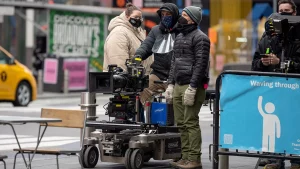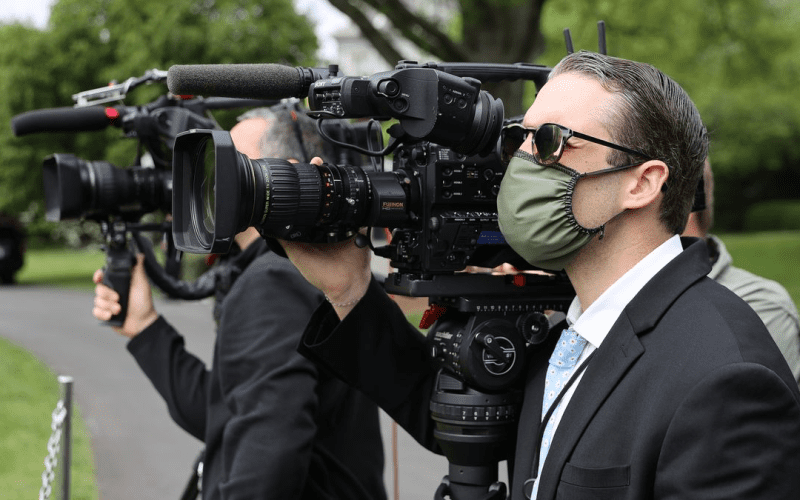Introduction
The COVID-19 pandemic has profoundly impacted every aspect of society, with the film industry experiencing some of the most significant changes. From production halts to altered viewing habits, the ramifications of the pandemic have reshaped how films are made, distributed, and consumed. This article explores these changes in detail, focusing on the challenges faced, the adaptations made by industry professionals, and the future of the film industry in a post-pandemic world.
The Immediate Impact of COVID-19 on Film Production

In early 2020, as COVID-19 spread quickly around the world, film productions stopped suddenly. Big studios and independent filmmakers had to stop filming to follow safety rules and lockdown orders. This pause caused big financial losses for production companies and left thousands of crew members and actors without jobs.
As filmmakers scrambled to adapt, they implemented strict health protocols and explored alternative production methods, such as remote filming and virtual collaborations.
Box Office Decline
The closure of cinemas around the world hit box office earnings hard. Big movie releases were delayed, and some films that had already come out saw a big drop in ticket sales. The usual cinema experience faced a major crisis because audiences could not go to theaters. This situation forced studios to rethink how they distribute films.
The Impact on Film Festivals

Before COVID-19, film festivals were an important way for filmmakers to showcase their work and connect with audiences. Events like Sundance and Cannes brought together stars, critics, and fans in large gatherings. However, during the pandemic, many festivals were canceled or held online. While some festivals tried virtual formats, they faced challenges in recreating the excitement of in-person events. This shift changed how films were promoted and discovered, and filmmakers had to adapt their strategies to reach audiences in new ways.
Changes in Distribution Models

The pandemic accelerated the shift from traditional cinema releases to digital platforms. With theaters closed or operating at reduced capacity, studios opted for direct-to-streaming releases. This change not only allowed audiences to access films from home but also shifted revenue models. This transition has forced studios to rethink their strategies for marketing and distribution, leading to the rise of premium video-on-demand (PVOD) services.
Shift Toward Virtual Events
As in-person gatherings became unsafe, filmmakers and studios started to host virtual events. Online premieres and Q&A sessions became popular ways to engage with audiences. This allowed fans to watch films from the comfort of their homes while still interacting with creators. Although it wasn’t the same as being in a theater, these virtual events helped keep the excitement alive and allowed fans to connect with their favorite filmmakers.
Emphasis on Safety Measures
During the pandemic, health and safety became a top priority for the film industry. Filmmakers and studios implemented strict safety measures on set. This included regular testing for crew members, social distancing, and wearing masks. These protocols helped protect everyone involved in making films and allowed productions to continue safely. While it created extra work, these measures became the new normal in filmmaking.
Audience Behavior and Viewing Habits

The pandemic changed how people watch movies. With theaters closed for long periods, many turned to streaming services for entertainment. This shift led to a rise in binge-watching, as viewers had more time at home. People also began to enjoy watching films with family and friends online, using platforms that allowed virtual gatherings. These changes in viewing habits may shape how films are made and distributed in the future.
The pandemic has significantly altered how audiences consume films. With theaters closed and social distancing measures in place, many turned to streaming services for entertainment. This shift has resulted in an increase in subscriptions and viewership for platforms like Netflix, Disney+, and Hulu.
As audiences adapted to new realities, their preferences shifted, with many expressing a desire for hybrid viewing options that combine both theater and home experiences.
Collaboration in Filmmaking
The pandemic encouraged collaboration between filmmakers and artists. Many creators from different backgrounds came together to produce films and projects. This sharing of ideas and resources led to new and innovative films. Working remotely also opened doors for global collaborations, as filmmakers could connect with talent worldwide. This trend could lead to richer storytelling in the future.
Long-Term Implications for the Film Industry

The changes brought on by COVID-19 are likely to have lasting effects on the film industry. The hybrid model of film releases, combining theatrical and digital platforms, may become the new norm. Studios will need to adapt their business models and marketing strategies to align with evolving audience preferences. Additionally, the pandemic has highlighted the importance of health and safety in film production, likely leading to more stringent regulations in the future.
1. Changing Consumer Habits
The pandemic has sped up changes in how people watch movies and shows. More viewers are choosing on-demand content that they can watch anytime. Because of this, studios are changing their release strategies, often choosing to release films in theaters and online at the same time. This approach is called a “day-and-date” release.
2. Financial Implications
The financial effects of the pandemic are still being felt in the film industry. Studios are looking closely at their budgets and production plans. As a result, smaller budgets and simpler productions may become more common as the industry tries to reduce financial risks.
Adaptation of Filmmaking Techniques
With health guidelines in place, filmmakers had to adapt their techniques. Many turned to smaller crews and fewer locations to keep everyone safe. Filmmakers also explored new technologies, such as remote filming and digital effects, to create compelling stories. These changes encouraged creativity and innovation, pushing filmmakers to think outside the box.
New Opportunities for Diverse Voices
The pandemic highlighted the importance of diverse storytelling in film. As audiences searched for more representation, filmmakers from different backgrounds gained visibility. Studios began to invest in projects that showcased unique perspectives and experiences. This change in focus helped to create a more inclusive film industry, giving a platform to voices that were often overlooked before.
Resilience of the Film Industry
Despite the challenges, the film industry has shown remarkable resilience. Filmmakers, studios, and theaters have adapted to the changing landscape, finding new ways to tell stories and connect with audiences. This adaptability has allowed the industry to keep moving forward, even in tough times. The lessons learned during the pandemic will shape the future of filmmaking and distribution, ensuring that the industry remains vibrant and innovative.
Financial Challenges for Theaters

The pandemic brought serious financial issues for movie theaters. Many theaters had to close or limit their capacity due to safety measures. As a result, ticket sales dropped, and some theaters even went out of business. With people becoming more comfortable watching movies at home, the traditional theater model faced tough competition. To survive, theaters must find new ways to attract audiences back, such as offering unique experiences or special events.
Table 4: Financial Impact on Theaters
| Factor | Before COVID-19 | After COVID-19 |
|---|---|---|
| Revenue Sources | Ticket sales and concessions | Decreased income from tickets |
| Customer Attendance | High turnout for releases | Lower attendance and closures |
| Business Model | Traditional theater model | Need for new strategies |
The Future of the Film Industry

Looking ahead, the film industry faces both challenges and opportunities. The pandemic has forced a reevaluation of traditional business models, leading to innovative approaches to filmmaking and distribution. As health concerns linger, studios may continue to prioritize streaming and digital releases alongside theatrical options. Here are some future trends to consider:
- Hybrid Release Models: Many studios may adopt a dual-release strategy, offering films in theaters and on streaming platforms simultaneously.
- Increased Focus on Streaming Content: Original content for streaming platforms will likely continue to grow, leading to more investment in diverse storytelling.
- Technological Innovations: Filmmakers may increasingly rely on technology, such as virtual reality (VR) and augmented reality (AR), to enhance storytelling and audience engagement.
Comparative Table
Analysis Table
Conclusion
The COVID-19 pandemic has forever changed the landscape of the film industry. While it has brought challenges, it has also opened doors to new opportunities and innovations. As the industry adapts to this new reality, the lessons learned during this tumultuous period will shape the future of filmmaking, distribution, and audience engagement.













